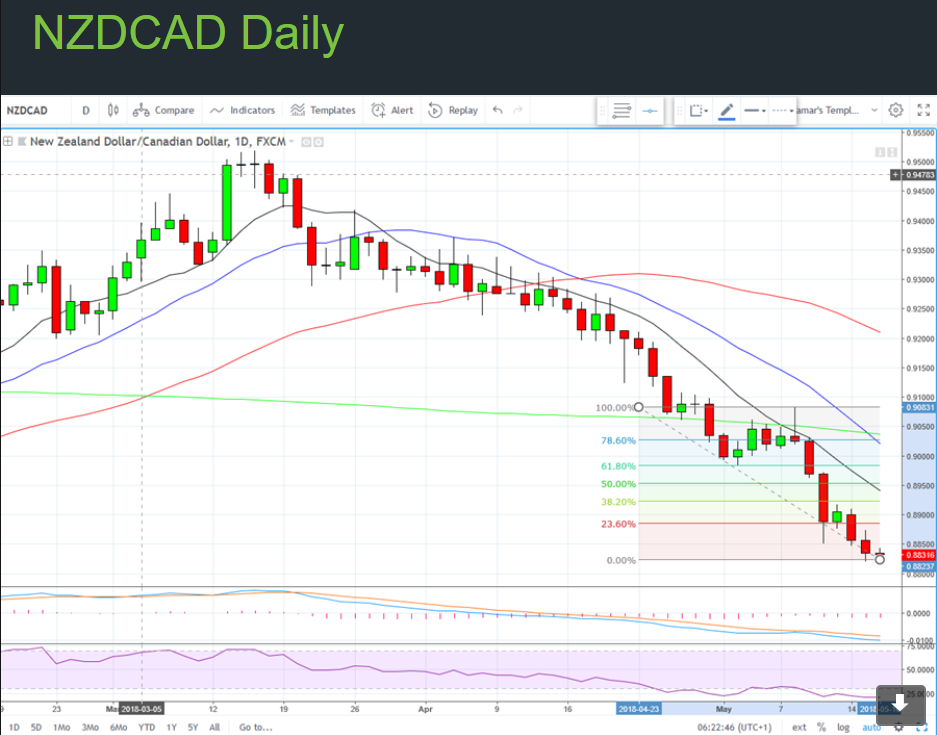The New Zealand Dollar Flagged Up As Best Sell Versus Strong Canadian Dollar
- NZD/CAD provides an optimum shorting opportunity, according to various models
- The pair is in an established downtrend on the daily chart
- The outlook for interest rates is considerably more bullish in Canada compared to NZ

© DragonImages, Adobe Stock
If you ever wanted to learn how to trade the financial markets, trading coaches at Trade With Precision (TWP) claim they can teach you how.
TWP also offers a service called Market Tracker (MT), an email sent to members which highlights the current best trading opportunities in the currency markets.
In Wednesday's MT one of the highlighted pairs is NZD/CAD which is currently in a strong bear trend, which TWP expect to continue - after a pull-back.
One of TWP's favourite strategies is to look for pairs which are strongly trending, wait for a pull-back and then enter in the direction of the trend at an opportune time, before riding the next phase higher or lower.
In the case of NZD/CAD, they expect a pull-back before a continuation down.
"NZD/CAD has seen strong selling pressure breaking through several strong S/R levels on the way down," says TWP, adding, "The market is currently overextended from its MAs and we are looking for a pullback into the sell zone which cluster with the sweet spot of the Fib retracement latest move."
After the pull-back, TWP say they will be "monitoring" the area for a "bearish candle for a potential PLT style trade entry short."

(Image courtesy of Trade With Precision)
Although the pair is in a short-term downtrend on the daily chart, there is no discernable trend on the weekly or monthly chart suggesting its too early to call a bear reversal.
"While with no confirmed trend on the weekly or the monthly chart, the market keeps on making LL on the weekly candles showing bearish strength," says TWP.
The bearish NZD/CAD call complements separate fundamental analysis from Westpac Bank who have a G10 currency portfolio model which allocates funds in varying amounts to the various G10 currencies in their portfolio depending on an assessment of 9 fundamental criteria.
The most recent results from the model, published on May 14, show an extremely bearish assessment of NZD on the one hand and extremely positive assessment of CAD on the other.
"Our suite of signals continue to lean heavily against NZD, the model upping it's short to 25% of the portfolio, the biggest position for the model," says Richard Farnulovich, an FX analyst at Westpac Bank.
In contrast to the model's extremely negative NZD position, it is extremely positive about CAD, allocating 23% of the portfolio to betting it will rise.

(Image courtesy of Westpac Bank)
The inference is that the optimum trade is the sell the weakest currency (NZD) versus the strongest (CAD) - the same call as TWP's technical recommendation.
It is not surprising both TWP and Westpac are bullish about the Canadian Dollar.
The currency is highly correlated to oil which is on the rise, unemployment is at 40-year lows, the head of the Bank of Canada (BOC) Steven Poloz wants to put up interest rates, and growth remains robust - however a major risk factor is the outcome of talks to renegotiate the North Atlantic Free Trade Agreement (NAFTA).
NAFTA risks are capping CAD gains because a negative outcome would be a terrible shock to the Canadian economy and by extension the Canadian Dollar.
Yet markets may be on the cusp of an announcement in relation to NAFTA given one mentioned deadline is May 17, and given the proximity of Mexican and US elections which are likely to focus negotiators on getting a result with which to woo voters.
Assuming a light adjustment to NAFTA, however, and CAD should shoot higher, since governor Poloz reiterated his commitment to raising interest rates recently, and markets are pricing in a 100% chance of a hike on May 30 when the BOC meets to decide.
Higher interest rates are the nectar and ambrosia of currencies and higher interest rates in Canada would push up the currency substantially; this is because foreign capital tends to flow to where it can earn the highest returns.
The Bullish Canadian outlook stands in sharp contrast to the fundamental outlook in New Zealand.
Here the governor of the Reserve Bank of New Zealand (RBNZ), Adrian Orr recently said he would be keeping interest rates on hold for "some time to come" leading to rout in NZD in the wake.
Apart from its relatively strong trade balance and balance of payments which oscillates between marginal deficits and surpluses, the currency has little to recommend it, and domestic factors appear to be a source of weakness.
Get up to 5% more foreign exchange by using a specialist provider to get closer to the real market rate and avoid the gaping spreads charged by your bank when providing currency. Learn more here.




